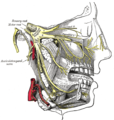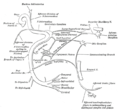Chorda tympani
| Chorda tympani | |
|---|---|
 The right membrana tympani with the hammer and the chorda tympani, viewed from within, from behind, and from above. | |
 Cranial nerves VII and VIII and selected structures of the inner and middle ear. 1 Nervus vestibularis, 2 Nervus cochlearis, 3 Nervus intermediofacialis, 4 Ganglion geniculi, 5 Chorda tympani, 6 Cochlea, 7 Ductus semicirculares, 8 Malleus, 9 Membrana tympani, 10 Tuba auditiva | |
| Details | |
| From | facial nerve |
| Identifiers | |
| MeSH | D002814 |
| TA98 | A14.2.01.084 A14.2.01.118 |
| TA2 | 6292 |
| FMA | 53228 |
| Anatomical terms of neuroanatomy | |
The chorda tympani is a nerve that branches from the facial nerve (cranial nerve VII) inside the facial canal, just before the facial nerve exits the skull via the stylomastoid foramen.
Chorda tympani is a branch of the facial nerve (the seventh cranial nerve) that serves the taste buds in the front of the tongue, runs through the middle ear, and carries taste messages to the brain.
The chorda tympani is part of one of three cranial nerves that are involved in taste. The taste system involves a complicated feedback loop, with each nerve acting to inhibit the signals of other nerves. The chorda tympani appears to exert a particularly strong inhibitory influence on other taste nerves, as well as on pain fibers in the tongue. When the chorda tympani is damaged, its inhibitory function is disrupted, leading to less inhibited activity in the other nerves.
Nerve fibers
The chorda tympani carries two types of nerve fibers from their origin with the facial nerve to the lingual nerve that carries them to their destinations:
- Special sensory fibers providing taste sensation from the anterior two-thirds of the tongue.
- Presynaptic parasympathetic fibers to the submandibular ganglion, providing secretomotor innervation to two salivary glands: the submandibular gland and sublingual gland and to the vessels of the tongue, which when stimulated, cause a dilatation of blood vessels of the tongue.
Path
Enters the skull through the internal acoustic meatus as part of the facial nerve, then it travels through the middle ear, where it runs from posterior to anterior across the tympanic membrane. It passes between the malleus and the incus, on the medial surface of the neck of the malleus.
The nerve continues through the petrotympanic fissure, after which it emerges from the skull into the infratemporal fossa. It soon combines with the larger lingual nerve, a branch of the mandibular nerve
The fibers of the chorda tympani travel with the lingual nerve to the submandibular ganglion.
Here, the preganglionic fibers fibers of the chorda tympani synapse with postganglionic fibers which go on to innervate the submandibular and sublingual salivary glands.
Special sensory (taste) fibers also extend from the chorda tympani to the anterior 2/3rds of the tongue via the lingual nerve.
Additional images
-
Mandible of human embryo 24 mm. long. Outer aspect.
-
Distribution of the maxillary and mandibular nerves, and the submaxillary ganglion.
-
Plan of the facial and intermediate nerves and their communication with other nerves.
-
The course and connections of the facial nerve in the temporal bone.
-
Sympathetic connections of the submaxillary and superior cervical ganglia.
-
View of the inner wall of the tympanum (enlarged.)
External links
- Anatomy figure: 27:03-08 at Human Anatomy Online, SUNY Downstate Medical Center
- Template:YaleCranialNerves
- MedEd at Loyola GrossAnatomy/h_n/cn/cn1/cnb7c.htm
- Template:EMedicineDictionary
- cranialnerves at The Anatomy Lesson by Wesley Norman (Georgetown University) (VII)
- Photo at Washington University
References and notes





